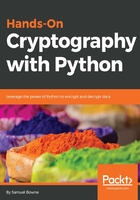
What this book covers
Chapter 1, Obfuscation, covers the Caesar cipher and ROT13, simple character substitution ciphers, and base64 encoding. We then move on to XOR. In the end, there are challenges to test your learning that involve cracking the Caesar cipher, reversing base64 encoding, and deciphering XOR encryption without the key.
Chapter 2, Hashing, covers the older MD5 and the newer SHA hashing techniques and also Windows password hashes. The weakest type of hashing is common use, followed by Linux password hashes, which are the strongest type of hashing in common use. Afterward, there are some challenges to complete. The first is to crack some Windows hashes and recover passwords, then you will be tasked with cracking hashes where you don't even know how many rounds of hashing algorithm were used, and finally you will be asked to crack those strong Linux hashes.
Chapter 3, Strong Encryption, covers the primary mode used to hide data today. It is strong enough for the US military. Then, there are two of its modes, ECB and CBC; CBC being the stronger and more common one. We will also discuss the padding oracle attack, which makes it possible to overcome some parts of AES CBC if the designer makes an error and the overly informative error message gives information to the attacker. Finally, we introduce RSA, the main public key algorithm used today, which makes it possible to send secrets over an insecure channel without having exchanged a gives private key. Following all that, we will perform a challenge where, we will crack RSA in the case where it is erroneously created with two similar prime numbers instead of two random prime numbers.